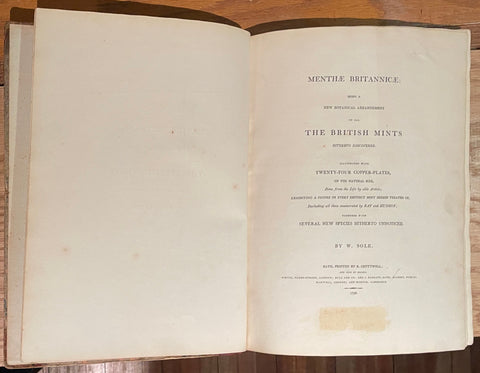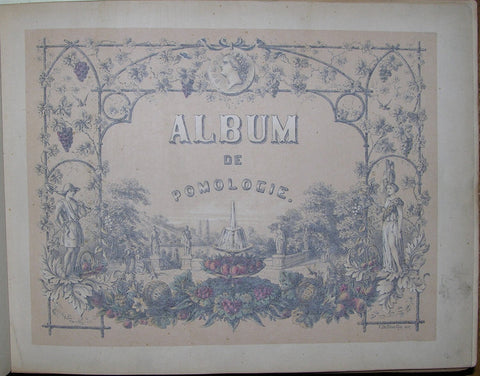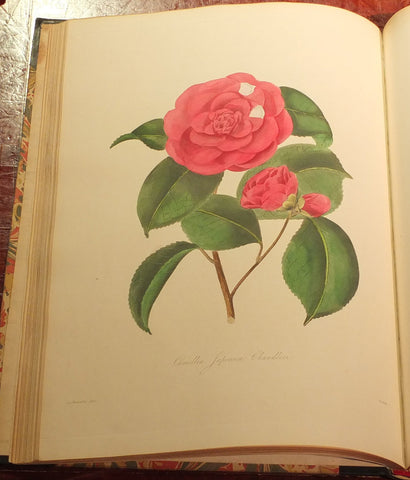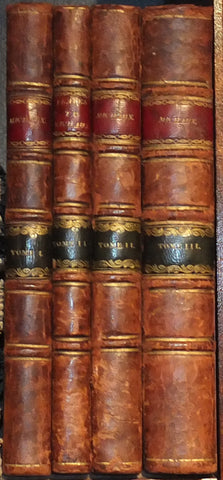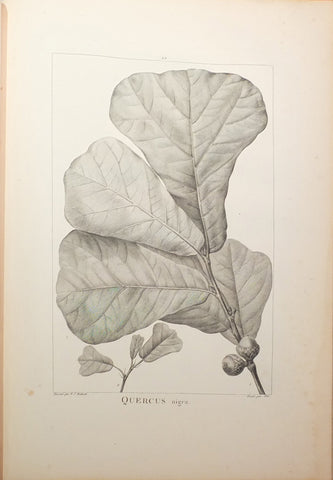William Sole (British, 1739-1802), Menthae Brittanicae: being a new botanical Arrangement of all the British Mints hitherto discovered.
William Sole (British, 1739-1802)
Menthae Brittanicae: being a new botanical Arrangement of all the British Mints hitherto discovered.
Folio (12 ¾ x 9 ¼ in.) Letterpress half-title, title page, and 53 pages of text interleaved with 26 delicate original watercolor drawings of British mints by the original artists: James Hewlett, Thomas Robins, and Miss J. Smith, all with manuscript captions, and including one folding.
Bath: Cruttwell, 1798.
First edition, Unique copy with the original watercolor drawings substituted for the 24 copper-plate engravings published without color in 1798 by the original artists.
Provenance: with ownership inscription of E. Lingwood on the front pastedown; the engraved armorial bookplate of Robert Maulkin Lingwood (?1813-1887) an amateur botanist on the front pastedown; with the engraved bookplate of the author’s relation Arthur B. Sole also on the front pastedown; Robert de Belder (1921-1995) and his wife Jelena de Belder-Koracic (1924-2003), horticulturalists and proprietors of Arboretum Kalmthout, their sale Sotheby’s April 28th, 1987, lot 340.
Condition: Modern calf-backed contemporary marbled paper boards (corners worn.)
William Sole is best known for his botanical research on mints which he grew in his garden from specimens collected throughout the United Kingdom. In 1798, he published his findings in Menthae Britannicae, accompanied by 24 full-plate etchings, all executed by William Hibbert from artwork by several artists.
Present here is a unique set of Sole’s outstanding work in which the 24 etched plates were replaced with original watercolors bearing manuscript annotations. We believe this example is William Sole’s copy of the book presenting the original artwork used to prepare etched plates. The annotations may be by William Sole and/or botanist J.E. Smith; a botanist Sole was consulting at his publication’s tail end. The combination of original watercolors and annotations is valuable both in its unique nature and in the process by which botanists reviewed and shared information.
S. Savage’s article, “William Sole’s unpublished Notes on His Menthae Britannicae 1798,” provides some intriguing insight on this unique set. Savage, stated the Linnean Society acquired an annotated set of Sole’s mints (annotated by R. Forster from information procured by William Sole) in 1936. Further, Savage wrote that the annotated collection was joining a group of plant pressings of mints that Sole presented to society in 1797. In 1798, Sole reclaimed the portfolio of cuttings to update his nomenclature. This renaming incident was a somewhat contentious episode. Around the time of the publication of this book, Sole introduced himself to botanist J.E. Smith. Smith had a difference in opinion on some specimens’ naming when he saw information Sole presented to him (maybe our set?). Sole responded that he would consider altering some of the plants’ names, but his plates were printed. The author of the article, S. Savage, in 1937 stated, “I have failed to trace that Sole’s own copy of his book ever reached the Linnean society.”
The present set may well be William Sole’s copy which bears annotations by him and possibly Smith. There are definitively at least two hands in the annotations on these watercolors. Further, there are numerous cross-outs/changes to the terminology. In one instance, the book has both the watercolor and the plate present. Upon further inspection of this pairing, the manuscript title and the plate title are different. The crossed-out name and the plate name are the same, but the printed text relays the revised expression. This watercolor is annotated with a new title, and underneath says, “now my [indescipherable].” This may be Smith’s handwriting or could indicate that William Sole was already planning another edition, reflecting the nomenclature change. The timeline matches what is known about this printing of this publication; the image plates printed as per Sole’s statement. Consequently, they had Sole’s original naming. However, the text pages must have been unfinished as they have the revised nomenclature.
William Sole (1739-1802) was born in Wichford, Cambridgeshire, the first son of John and Martha Sole.
Sole was educated at the Kings Ely (the Kings School) and apprenticed at for an apothecary Robert Cory of Cambridge. After, he opened a solo apothecary practice in Bath and later a practice in partnership with Thomas West on historic Trim Street, in Bath, Somerset.
In 1788, Sole was chosen as one of its first associates of the Linnean Society. Through this association, he carried on a long correspondence with John Pitchford of Norwich, an early friend of Sir James Edward Smith, on the subject of mints. Sole is best known for his botanical research about mints which he grew in his garden from specimens collected throughout the United Kingdom. In 1798, he published his findings in Menthae Britannicae, accompanied by 24 full-plate etchings, all executed by William Hibbert from artwork by several artists. He also prepared an account of the principal English grasses and their agricultural uses, with specimens, which he presented to the Bath and West of England Agricultural Society in 1799. Society presented him with a silver tankard in return. He died unmarried in 1802
According to William Sole’s will, he dispersed his estate between several siblings. Though the handwriting is difficult to decipher, it indicates his books and other rarities were left to his brother John (b. 1741).
A bookplate in the front pastedown of the book includes ‘Arthur B. Sole.’ Arthur Baron Sole (British, 1853-1903) was a great-nephew of William Sole, the author of this book. Arthur was the fourth son of Dr. William Sole and Anne Anslow. He was a parish priest at the Church of St. Thomas, Winchester, England.
Also, there is a bookplate featuring the Lingwood family arms with the motto ‘crede deo’ (Trust in God), and the individual ‘R.M. Lingwood’ is also present on the pastedown. This is presumed to be Robert Maulkin Lingwood (British, 1813-1877), a botanist and entomologist who discovered several plants in the Channel Islands and Ireland. He would have indeed used Sole’s work in his study of native plants. The Lingwood and Sole families intermarried, which explains the presence of both bookplates.
Several artists contributed to the original imagery for Menthae Brittanicae. The artists tapped for the task were not nameless artisans, they were well known in their time. Their known biographies are outlined below:
James Hewlett (1768-1836) was a son of a gardener. Although now an obscure painter, Hewlett was something of an art star in his day. He produced highly detailed studies of fruit and flowers. His pieces were admired for their beauty and botanical accuracy. In 1807, he caused a stir in the London art market when one of his flower paintings sold for £400. He was something of a celebrity in Bath, and when Queen Charlotte came in 1817 to take a spa treatment, she made a high-profile visit to Hewlett’s studio.
Thomas Robins the Younger (1748-1806) followed his father, Thomas Robins (1716-1770), as a painter of decorative watercolors of houses and gardens. He also made studies of plants and insects and occasionally painted landscapes.
Miss J. Smith (fl. 1797-1809), the mysterious Miss Smith’s work is primarily known through her illustrations in Studies of Flowers from Nature, a 19th-century botanical type book for young women’s artistic instruction. This training manual included highly detailed black and white engravings by Smith, which the buyer could color herself. Few have survived.
Please feel free to contact us with questions by phone at 215.735.8811,
or by email at loricohen@aradergalleries.
We Also Recommend

